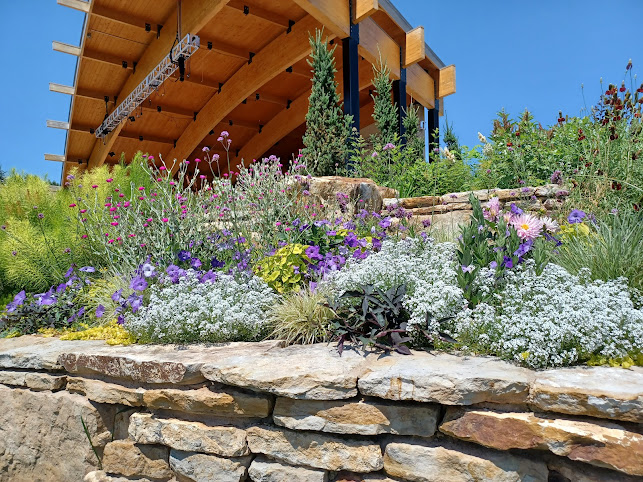By Andrew Scott, Horticulturist
The summer concert series at the Gardens on Spring Creek is in full swing as legendary performers like WAR, Ricky Skaggs, and Blood, Sweat & Tears still plan on taking the stage, and what a unique stage it is! There are plenty of iconic venues that we love in northern Colorado... but few of these let performers do their thing surrounded by a lively pallet of specially curated plants. Unlike a lot of music venues, the Everitt Pavilion allows you to admire a diverse selection of perennial shrubs, forbs, grasses, and succulents, as well as rotating seasonal annual displays in the open air while basking in the dog days of summer, jamming to some rockin’ tunes.
This year’s annual display was designed by horticulturist and propagator Kelly Kellow and follows a general theme of popping pinks and purples with accents of lime green and white. Time tested classics mingle with more modern stunners to make a wonderfully coherent collage of color!
There are primarily three thrillers in the displays intended to inspire awe (but not distract from the performances, of course). Dahlia XXL ‘Veracruz’ is an adorable miniature dahlia that reaches about two feet tall with abundant XXL pale pink ombre blooms, offering pops of pastel all season long. This contrasts with the spire of deep indigo snapdragons ascending from the mounds of ‘Velocity Blue’ Salvia’s pale green foliage. Not only do they look brilliant, butterflies and hummingbirds can’t get enough of them; it’s hummingbird season at the Gardens now too, so you might just see one whiz by during your next visit! The last thriller is exceptionally whimsical and one we always get questions about. When planted alone, Verbena ‘Cloud’ is a spindly little rascal, but adds wispy pockets of purple when densely planted or arranged into a display. Its thin stems and sparse foliage playfully sway in the breeze, but this thinness also makes it prone to snapping, so pruning it a bit shorter can help remedy this and keep the dense, if tiny, clusters going all summer.

Filling the spaces between these thrillers are cultivars representing a range of plant families. Two kinds of petunias sprawl across the ground: Easy Wave™ ‘Lavender Sky Blue’ and Sweetunia™ ‘Lavender Shimmer’. Although their foliage isn’t anything to write home about, ‘Lavender Sky Blue’ blooms sport a bold periwinkle look while those of ‘Lavender Shimmer’ have a much more laid-back lilac hue with almost a steely gray undertone that plays off its flashy sister quite well.
A hybrid of Zinnia angustifolia and Zinnia elegans, Zinnia Profusion™ ‘Double White’ lives up to its name with a profusion of sizable creamy to alabaster double blooms with yellow eyes and adds little pockets of negative space to the display along with its muted leaves. The flowers look great even after the primary bloom is spent and dried and the hybrid has been bred to be exceptionally disease resistant, so it looks presentable all summer long. Coleus is another classic filler, especially when it gets plenty of water and becomes nice and bushy. Premium Sun™ ‘Lime Delight’ is exactly what it says on the tin: a spreading mound of delightfully lime green leaves with a crinkly texture. Ornamental bunchgrasses also make excellent fillers, like fountain grass Pennisetum ‘Sky Rocket’. True to its name, fountain grass erupts with a foot tall spray of pale green blades with nifty white margins; bristly, nodding seed heads appear later in the season and can be pale or have a soft reddish hue to them.

Finally, spillers were placed on the borders and allowed to spill onto and over the terrace’s retaining walls to add some loosey-goosey flow to the design. Sweet potato vine is a classic spiller: intriguing palmate leaves, fast growing, lies flat, and foliage that comes in a variety of color. Usually pale green to deep purple, either one would have been a suitable choice, but Kelly went with Ipomea batatas ‘Blackie’ to contrast with the variably violet to white blooms of Lobularia ‘Lavender Stream’. Lobularia in general blooms in such packed racemes that they quickly cover the foliage and leave you with the cutest clusters of flowers flowing over your borders. Later in the season, with enough water, ‘Blackie’ will bloom large lavender petals with a deep violet eye, again contrasting with the bitty flowers of ‘Lavender Streams’.
If you’ve never been to a concert at the Gardens on Spring Creek, first of all, you’re missing out. Second, you’re always more than welcome to visit any other day this summer to see how nice these plants play together and get some ideas for your beds and containers (the flowers will stay until fall’s first frost, but they look their best now!). Be sure to come back next year to see the brand new arrangement designed by yours truly!